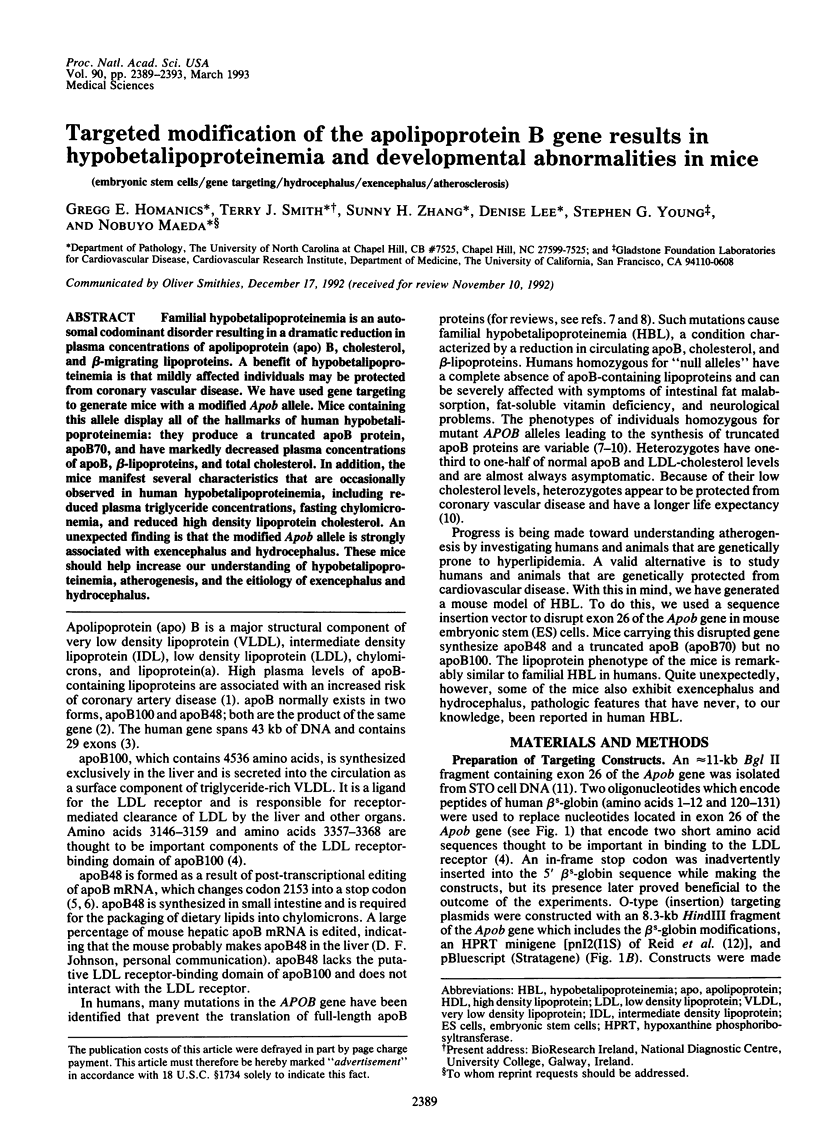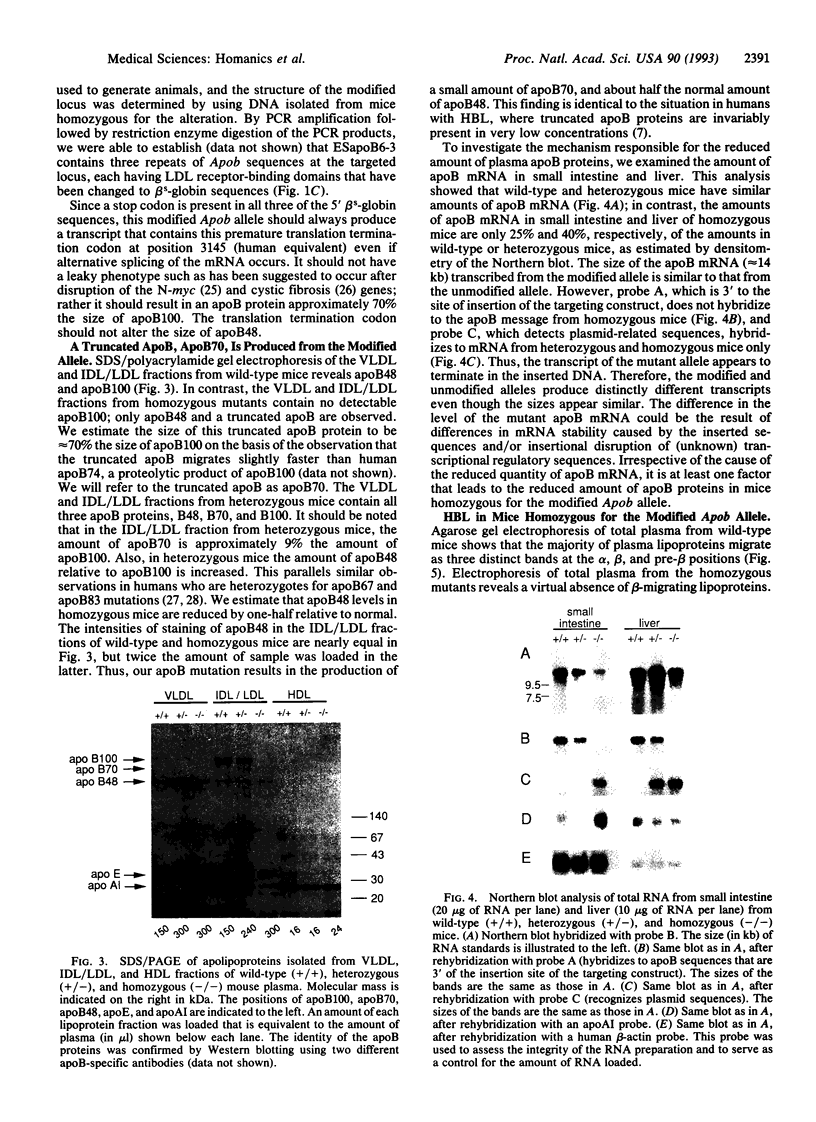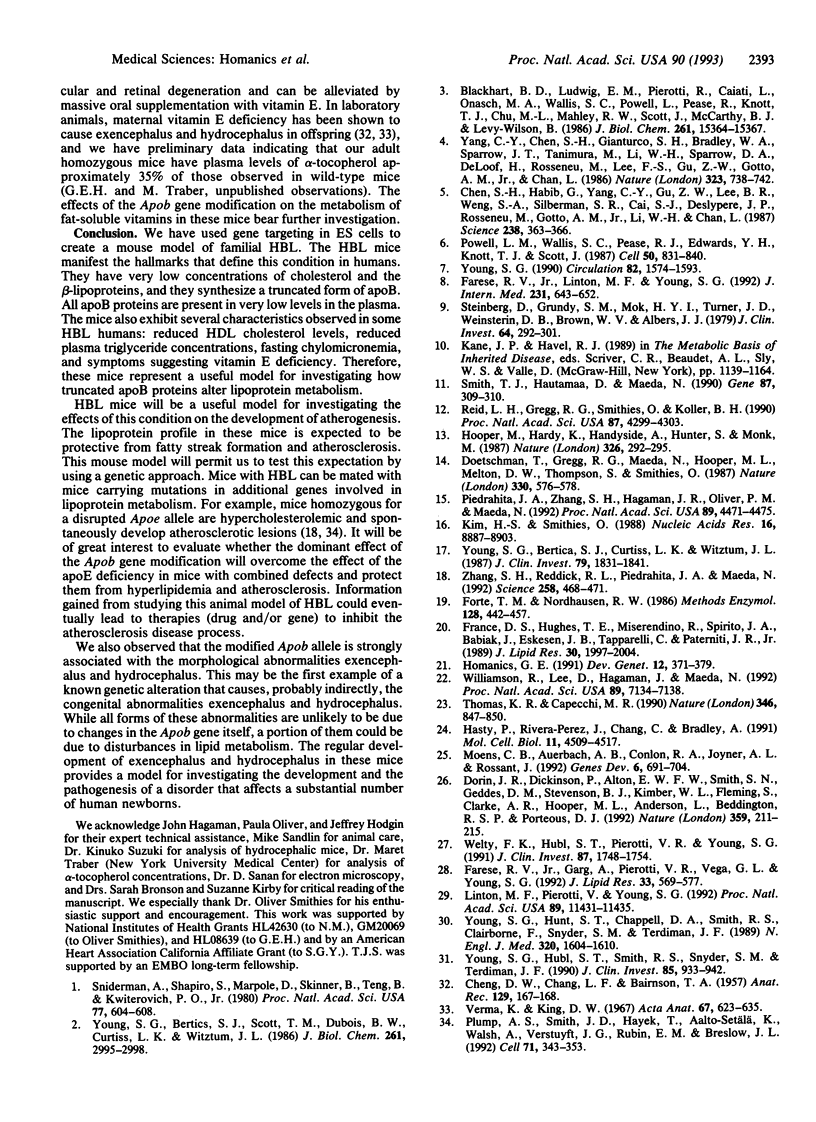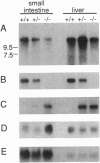Abstract
Familial hypobetalipoproteinemia is an autosomal codominant disorder resulting in a dramatic reduction in plasma concentrations of apolipoprotein (apo) B, cholesterol, and beta-migrating lipoproteins. A benefit of hypobetalipoproteinemia is that mildly affected individuals may be protected from coronary vascular disease. We have used gene targeting to generate mice with a modified Apob allele. Mice containing this allele display all of the hallmarks of human hypobetalipoproteinemia: they produce a truncated apoB protein, apoB70, and have markedly decreased plasma concentrations of apoB, beta-lipoproteins, and total cholesterol. In addition, the mice manifest several characteristics that are occasionally observed in human hypobetalipoproteinemia, including reduced plasma triglyceride concentrations, fasting chylomicronemia, and reduced high density lipoprotein cholesterol. An unexpected finding is that the modified Apob allele is strongly associated with exencephalus and hydrocephalus. These mice should help increase our understanding of hypobetalipoproteinemia, atherogenesis, and the etiology of exencephalus and hydrocephalus.
Full text
PDF




Images in this article
Selected References
These references are in PubMed. This may not be the complete list of references from this article.
- Blackhart B. D., Ludwig E. M., Pierotti V. R., Caiati L., Onasch M. A., Wallis S. C., Powell L., Pease R., Knott T. J., Chu M. L. Structure of the human apolipoprotein B gene. J Biol Chem. 1986 Nov 25;261(33):15364–15367. [PubMed] [Google Scholar]
- CHENG D. W., CHANG L. F., BAIRNSON T. A. Gross observations on developing abnormal embryos induced by maternal vitamin E deficiency. Anat Rec. 1957 Oct;129(2):167–185. doi: 10.1002/ar.1091290204. [DOI] [PubMed] [Google Scholar]
- Chen S. H., Habib G., Yang C. Y., Gu Z. W., Lee B. R., Weng S. A., Silberman S. R., Cai S. J., Deslypere J. P., Rosseneu M. Apolipoprotein B-48 is the product of a messenger RNA with an organ-specific in-frame stop codon. Science. 1987 Oct 16;238(4825):363–366. doi: 10.1126/science.3659919. [DOI] [PubMed] [Google Scholar]
- Doetschman T., Gregg R. G., Maeda N., Hooper M. L., Melton D. W., Thompson S., Smithies O. Targetted correction of a mutant HPRT gene in mouse embryonic stem cells. Nature. 1987 Dec 10;330(6148):576–578. doi: 10.1038/330576a0. [DOI] [PubMed] [Google Scholar]
- Dorin J. R., Dickinson P., Alton E. W., Smith S. N., Geddes D. M., Stevenson B. J., Kimber W. L., Fleming S., Clarke A. R., Hooper M. L. Cystic fibrosis in the mouse by targeted insertional mutagenesis. Nature. 1992 Sep 17;359(6392):211–215. doi: 10.1038/359211a0. [DOI] [PubMed] [Google Scholar]
- Farese R. V., Jr, Garg A., Pierotti V. R., Vega G. L., Young S. G. A truncated species of apolipoprotein B, B-83, associated with hypobetalipoproteinemia. J Lipid Res. 1992 Apr;33(4):569–577. [PubMed] [Google Scholar]
- Farese R. V., Jr, Linton M. F., Young S. G. Apolipoprotein B gene mutations affecting cholesterol levels. J Intern Med. 1992 Jun;231(6):643–652. doi: 10.1111/j.1365-2796.1992.tb01253.x. [DOI] [PubMed] [Google Scholar]
- Forte T. M., Nordhausen R. W. Electron microscopy of negatively stained lipoproteins. Methods Enzymol. 1986;128:442–457. doi: 10.1016/0076-6879(86)28086-6. [DOI] [PubMed] [Google Scholar]
- France D. S., Hughes T. E., Miserendino R., Spirito J. A., Babiak J., Eskesen J. B., Tapparelli C., Paterniti J. R., Jr Nonimmunochemical quantitation of mammalian apolipoprotein A-I in whole serum or plasma by nonreducing gel electrophoresis. J Lipid Res. 1989 Dec;30(12):1997–2004. [PubMed] [Google Scholar]
- Hasty P., Rivera-Pérez J., Chang C., Bradley A. Target frequency and integration pattern for insertion and replacement vectors in embryonic stem cells. Mol Cell Biol. 1991 Sep;11(9):4509–4517. doi: 10.1128/mcb.11.9.4509. [DOI] [PMC free article] [PubMed] [Google Scholar]
- Homanics G. E. Morphological abnormalities, neonatal mortality, and reproductive abnormalities in mice transgenic for diphtheria toxin genes that are driven by the promoter for adipocyte lipid binding protein. Dev Genet. 1991;12(5):371–379. doi: 10.1002/dvg.1020120506. [DOI] [PubMed] [Google Scholar]
- Hooper M., Hardy K., Handyside A., Hunter S., Monk M. HPRT-deficient (Lesch-Nyhan) mouse embryos derived from germline colonization by cultured cells. Nature. 1987 Mar 19;326(6110):292–295. doi: 10.1038/326292a0. [DOI] [PubMed] [Google Scholar]
- Kim H. S., Smithies O. Recombinant fragment assay for gene targetting based on the polymerase chain reaction. Nucleic Acids Res. 1988 Sep 26;16(18):8887–8903. doi: 10.1093/nar/16.18.8887. [DOI] [PMC free article] [PubMed] [Google Scholar]
- Linton M. F., Pierotti V., Young S. G. Reading-frame restoration with an apolipoprotein B gene frameshift mutation. Proc Natl Acad Sci U S A. 1992 Dec 1;89(23):11431–11435. doi: 10.1073/pnas.89.23.11431. [DOI] [PMC free article] [PubMed] [Google Scholar]
- Moens C. B., Auerbach A. B., Conlon R. A., Joyner A. L., Rossant J. A targeted mutation reveals a role for N-myc in branching morphogenesis in the embryonic mouse lung. Genes Dev. 1992 May;6(5):691–704. doi: 10.1101/gad.6.5.691. [DOI] [PubMed] [Google Scholar]
- Piedrahita J. A., Zhang S. H., Hagaman J. R., Oliver P. M., Maeda N. Generation of mice carrying a mutant apolipoprotein E gene inactivated by gene targeting in embryonic stem cells. Proc Natl Acad Sci U S A. 1992 May 15;89(10):4471–4475. doi: 10.1073/pnas.89.10.4471. [DOI] [PMC free article] [PubMed] [Google Scholar]
- Plump A. S., Smith J. D., Hayek T., Aalto-Setälä K., Walsh A., Verstuyft J. G., Rubin E. M., Breslow J. L. Severe hypercholesterolemia and atherosclerosis in apolipoprotein E-deficient mice created by homologous recombination in ES cells. Cell. 1992 Oct 16;71(2):343–353. doi: 10.1016/0092-8674(92)90362-g. [DOI] [PubMed] [Google Scholar]
- Powell L. M., Wallis S. C., Pease R. J., Edwards Y. H., Knott T. J., Scott J. A novel form of tissue-specific RNA processing produces apolipoprotein-B48 in intestine. Cell. 1987 Sep 11;50(6):831–840. doi: 10.1016/0092-8674(87)90510-1. [DOI] [PubMed] [Google Scholar]
- Reid L. H., Gregg R. G., Smithies O., Koller B. H. Regulatory elements in the introns of the human HPRT gene are necessary for its expression in embryonic stem cells. Proc Natl Acad Sci U S A. 1990 Jun;87(11):4299–4303. doi: 10.1073/pnas.87.11.4299. [DOI] [PMC free article] [PubMed] [Google Scholar]
- Smith T. J., Hautamaa D., Maeda N. Sequence of the putative low-density lipoprotein receptor-binding regions of apolipoprotein B in mouse and hamster. Gene. 1990 Mar 15;87(2):309–310. doi: 10.1016/0378-1119(90)90319-m. [DOI] [PubMed] [Google Scholar]
- Sniderman A., Shapiro S., Marpole D., Skinner B., Teng B., Kwiterovich P. O., Jr Association of coronary atherosclerosis with hyperapobetalipoproteinemia [increased protein but normal cholesterol levels in human plasma low density (beta) lipoproteins]. Proc Natl Acad Sci U S A. 1980 Jan;77(1):604–608. doi: 10.1073/pnas.77.1.604. [DOI] [PMC free article] [PubMed] [Google Scholar]
- Steinberg D., Grundy S. M., Mok H. Y., Turner J. D., Weinstein D. B., Brown W. V., Albers J. J. Metabolic studies in an unusual case of asymptomatic familial hypobetalipoproteinemia with hypolphalipoproteinemia and fasting chylomicronemia. J Clin Invest. 1979 Jul;64(1):292–301. doi: 10.1172/JCI109451. [DOI] [PMC free article] [PubMed] [Google Scholar]
- Thomas K. R., Capecchi M. R. Targeted disruption of the murine int-1 proto-oncogene resulting in severe abnormalities in midbrain and cerebellar development. Nature. 1990 Aug 30;346(6287):847–850. doi: 10.1038/346847a0. [DOI] [PubMed] [Google Scholar]
- Verma K., Wei King D. Disorders of the developing nervous system of vitamin E-deficient rats. Acta Anat (Basel) 1967;67(4):623–635. doi: 10.1159/000143009. [DOI] [PubMed] [Google Scholar]
- Welty F. K., Hubl S. T., Pierotti V. R., Young S. G. A truncated species of apolipoprotein B (B67) in a kindred with familial hypobetalipoproteinemia. J Clin Invest. 1991 May;87(5):1748–1754. doi: 10.1172/JCI115193. [DOI] [PMC free article] [PubMed] [Google Scholar]
- Williamson R., Lee D., Hagaman J., Maeda N. Marked reduction of high density lipoprotein cholesterol in mice genetically modified to lack apolipoprotein A-I. Proc Natl Acad Sci U S A. 1992 Aug 1;89(15):7134–7138. doi: 10.1073/pnas.89.15.7134. [DOI] [PMC free article] [PubMed] [Google Scholar]
- Yang C. Y., Chen S. H., Gianturco S. H., Bradley W. A., Sparrow J. T., Tanimura M., Li W. H., Sparrow D. A., DeLoof H., Rosseneu M. Sequence, structure, receptor-binding domains and internal repeats of human apolipoprotein B-100. Nature. 1986 Oct 23;323(6090):738–742. doi: 10.1038/323738a0. [DOI] [PubMed] [Google Scholar]
- Young S. G., Bertics S. J., Curtiss L. K., Witztum J. L. Characterization of an abnormal species of apolipoprotein B, apolipoprotein B-37, associated with familial hypobetalipoproteinemia. J Clin Invest. 1987 Jun;79(6):1831–1841. doi: 10.1172/JCI113025. [DOI] [PMC free article] [PubMed] [Google Scholar]
- Young S. G., Bertics S. J., Scott T. M., Dubois B. W., Curtiss L. K., Witztum J. L. Parallel expression of the MB19 genetic polymorphism in apoprotein B-100 and apoprotein B-48. Evidence that both apoproteins are products of the same gene. J Biol Chem. 1986 Mar 5;261(7):2995–2998. [PubMed] [Google Scholar]
- Young S. G., Hubl S. T., Chappell D. A., Smith R. S., Claiborne F., Snyder S. M., Terdiman J. F. Familial hypobetalipoproteinemia associated with a mutant species of apolipoprotein B (B-46). N Engl J Med. 1989 Jun 15;320(24):1604–1610. doi: 10.1056/NEJM198906153202407. [DOI] [PubMed] [Google Scholar]
- Young S. G., Hubl S. T., Smith R. S., Snyder S. M., Terdiman J. F. Familial hypobetalipoproteinemia caused by a mutation in the apolipoprotein B gene that results in a truncated species of apolipoprotein B (B-31). A unique mutation that helps to define the portion of the apolipoprotein B molecule required for the formation of buoyant, triglyceride-rich lipoproteins. J Clin Invest. 1990 Mar;85(3):933–942. doi: 10.1172/JCI114522. [DOI] [PMC free article] [PubMed] [Google Scholar]
- Young S. G. Recent progress in understanding apolipoprotein B. Circulation. 1990 Nov;82(5):1574–1594. doi: 10.1161/01.cir.82.5.1574. [DOI] [PubMed] [Google Scholar]
- Zhang S. H., Reddick R. L., Piedrahita J. A., Maeda N. Spontaneous hypercholesterolemia and arterial lesions in mice lacking apolipoprotein E. Science. 1992 Oct 16;258(5081):468–471. doi: 10.1126/science.1411543. [DOI] [PubMed] [Google Scholar]






